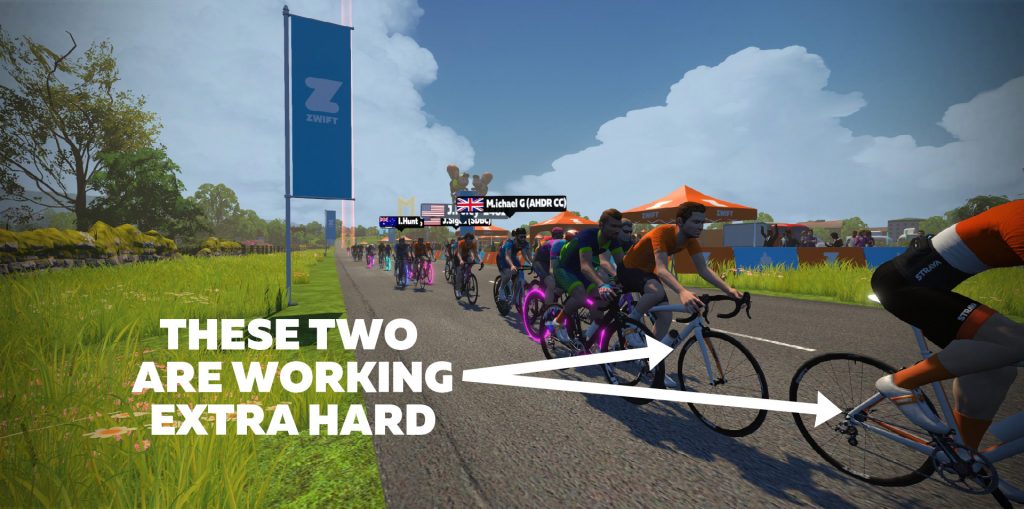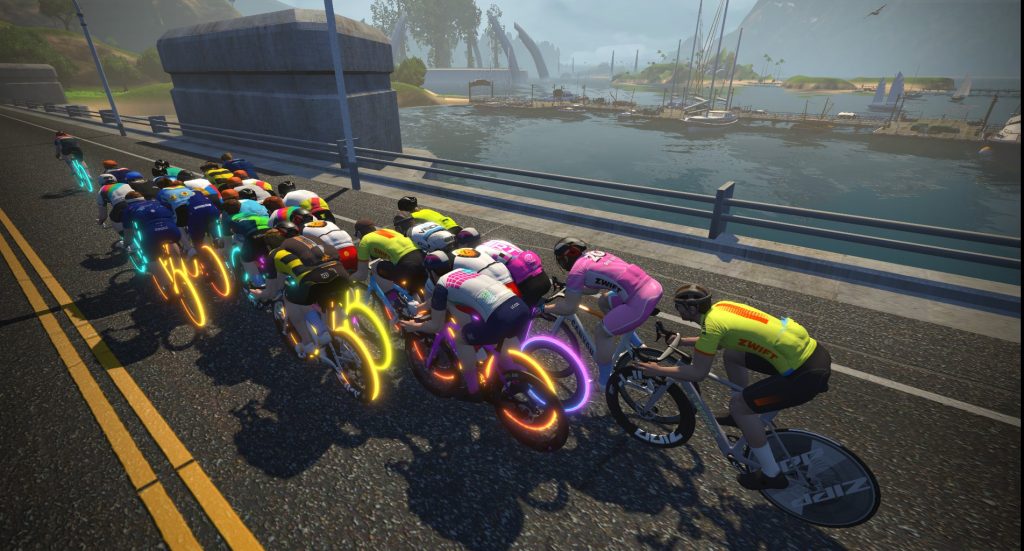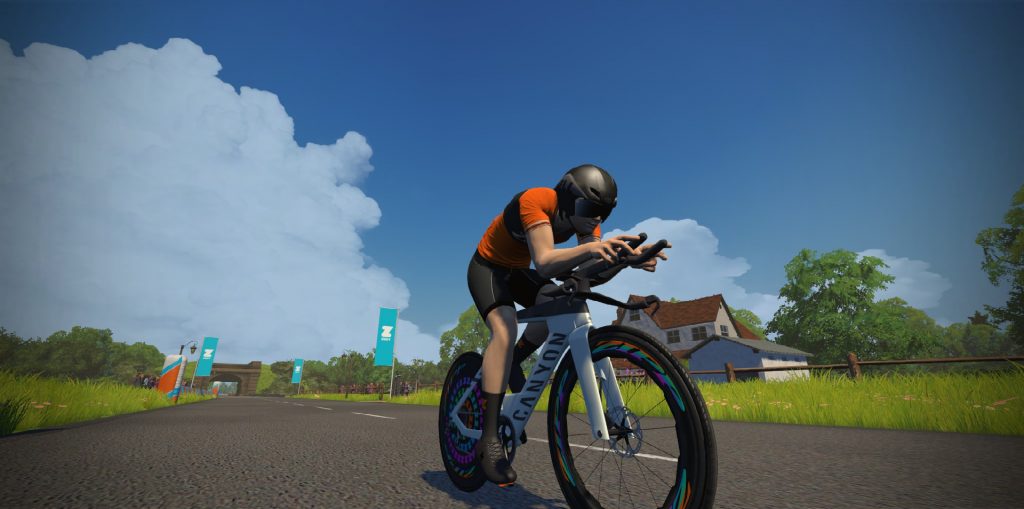Recently I joined the crew at No Breakaways for an “Outside the Draft” vodcast where we talked about all things Zwift racing (watch it here). During that chat, host Rick Wenger asked me a question: does bike choice really matter in Zwift? What you see below is the written version of my answer to Rick.
First, the Basics
Zwift uses several factors to determine your speed in its virtual world. Your weight, height, and wattage output are three “personal” factors. But the virtual world also affects your speed – so you’ll go slower up a virtual climb, faster when you’re drafting, slower on certain road surfaces, etc.
The final factor is the virtual bike you select. At the time of this post, Zwift has 80+ bike frames and 30+ wheelsets available. Each frame and wheelset has its own weight and CdA setting in game, and these affect your in-game speed just like they would outside. A lighter setup will climb faster than a heavier rig, and a more aero (low CdA) setup will go faster at higher speeds than one less aero.
Some bike frames and wheelsets are unlocked via in-game events or challenges, but most need to be purchased from the Drop Shop in order to be used.
Learn how to purchase frames and wheels from Zwift’s Drop Shop >
Racing Only
I should say, this article is written in the context of Zwift racing. If you’re on Zwift free riding, doing workouts, exploring new maps, or enjoying social rides, having the fastest bike really isn’t a big deal. Just like riding outside – you may take your comfortable “endurance bike” out for a long easy ride with friends, then ride your aero race bike in the crit.
Three Groups of Riders
Now, to the question at hand: does bike choice really matter in Zwift? This question is best answered by breaking Zwift racers into three cohorts and giving each their own answer:
- Zwift Newbies: riders at lower XP levels who aren’t Zwift experts
- Experienced Zwifters: riders with access to most or all of the fastest wheels and frames (including the Tron bike)
- TT Racers: anyone racing in a time trial format
Zwift Newbies: Upgrade Your Ride
It seems that every time I line up for a Zwift race, someone in the start pen is on the stock Zwift Carbon frame and 32mm wheels. Our speed tests show (at 300W steady, 75kg weight, 183cm height) this stock Zwift setup takes 51:36 to complete our flat test course.
By comparison, a fairly accessible setup (Canyon Aeroad 2021 frame + Zipp 808 wheels) turns in a flat test time of 50:38 (58s faster). A bit of fancy math and physics shows us that this difference is roughly equivalent to a 15W average power savings across an hour-long race. That’s a significant, noticeable difference – one that will get you dropped when the going gets tough.

What about climbing? The stock Zwift setup completed our Alpe du Zwift test in 49:48.
By comparison, the easily attainable Specialized Tarmac Pro or Cannondale EVO frames could be paired with the low-level unlocked ENVE 3.4 or DT Swiss ARC 62 wheels to turn in a time of 48:49 (59s faster). This works out to approximately 7W saved – less significant than the flat test, but probably noticeable if you’re on the rivet. (And you will be, racing up the Alpe!)
Conclusion: newer Zwifters should upgrade from the stock frame and wheels to a decent entry-level race setup. It will save you significant wattage, especially in flat/rolling races.
Experienced Zwifters: It’s Mostly Mental

Zwifters who have been around for years earn the luxury of a garage full of fast bikes. Having all these nice rigs at our disposal, though, can make bike selection even more confusing, because differences between setups are so minor.
For example: the 8 frames on our fastest frames list are separated by just 3 seconds in our ~50-minute flat test. And the 6 wheels on our fastest wheelsets list are separated by just 10 seconds.
Do the math, and the difference between the slowest and fastest setups pulled from our fastest frames and wheels lists works out to just 3-4W. That won’t be noticeable by most, especially if you’re spending a good portion of your race sitting in the draft and not pushing to your very limit. When the time comes to push, 3-4W isn’t going to make or break your success.
For climbing rigs, the difference is even less remarkable. The 8 wheelsets on our fastest climbers list are separated by just 8 seconds, while the 7 frames on our fastest climbers list are separated by just 4 seconds. That 12-second difference works out to only 1-2 watts saved.
But here’s the caveat: for many racers (including myself), knowing you’re on a fast bike (even virtually) gives an important mental advantage. Even if your bike isn’t noticeably faster than the next option, if you think you’re on the fastest rig available, you don’t have that irksome “My bike is slowing me down” thought in the back of your mind.
Conclusion: experienced Zwifters with access to most or all of the fastest setups can rest assured that any of the fastest rigs will work just fine. If the mental game is important, then it’s probably worth doing a bit of research and picking the fastest frame for your course.
TT Racers: Leave Nothing On the Table
The time trial is called “the race of truth” for good reason: you don’t get to hide in the draft.
In a typical road race, many riders spend much of the time trying to conserve their energy so they can attack (or survive!) at key pinch points. The goal of a standard road race is to be the first over the line, and often that means winners sit in the draft and wait for the right time to attack near the end of the race.
In a TT, however, your goal is speed. And only you control your speed – there is no drafting. In this scenario, you should do everything you can to maximize your speed. That means pacing smartly, but it also means picking the fastest setup.

The 6 TT frames on our fastest TT frames list are separated by 13 seconds, while the 6 wheelsets on our fastest wheelsets list are separated by 10 seconds. That’s a 23-second difference between the slowest “fast” rig and the very fastest rig in a ~50-minute flat TT race. That’s a big difference!
TT races are often decided by just a few seconds. If a different wheelset or frame can slice anything off your time, why wouldn’t you use it?
The same principle holds true in a team time trial setting. When every team member is taking turns pulling on the front, each of their bike choices matters. Think of it like this: if every rider except one in a 4-man TTT squad had the fastest bike available, and that one rider choose a rig that was 10s slower over the course of the race, that rider would cost the squad 2.5 seconds in overall time if everyone took an equal number of pulls.
Conclusion: get the fastest rig available for time trials. Anything else and you’re handing places to the competition.
Wrapping It Up
While my answer to the “Does bike choice matter?” question isn’t a simple one, hopefully it is clear enough to help Zwifters of all stripes.
In the end, bike upgrading on Zwift is similar to what we see in outdoor riding: newbies will see noticeable improvements by upgrading to even a basic race rig, expert racers won’t see much improvement at all between different high-end setups, and TT riders are smart to obsess over getting the very fastest setup.
Questions or Comments?
Share below!
